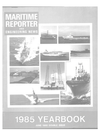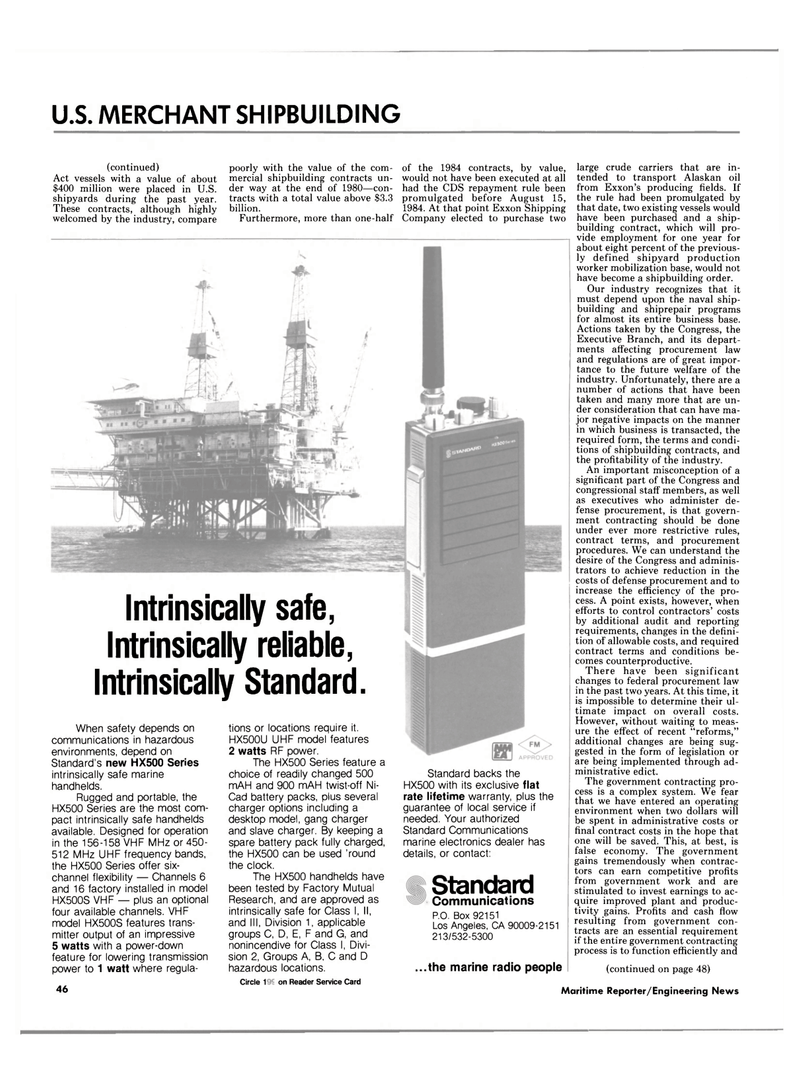
Page 48: of Maritime Reporter Magazine (June 1985)
Read this page in Pdf, Flash or Html5 edition of June 1985 Maritime Reporter Magazine
U.S. MERCHANT SHIPBUILDING (continued)
Act vessels with a value of about $400 million were placed in U.S. shipyards during the past year.
These contracts, although highly welcomed by the industry, compare poorly with the value of the com- mercial shipbuilding contracts un- der way at the end of 1980—con- tracts with a total value above $3.3 billion.
Furthermore, more than one-half of the 1984 contracts, by value, would not have been executed at all had the CDS repayment rule been promulgated before August 15, 1984. At that point Exxon Shipping
Company elected to purchase two
Intrinsically safe,
Intrinsically reliable,
Intrinsically Standard.
When safety depends on communications in hazardous environments, depend on
Standard's new HX500 Series intrinsically safe marine handhelds.
Rugged and portable, the
HX500 Series are the most com- pact intrinsically safe handhelds available. Designed for operation in the 156-158 VHF MHz or 450- 512 MHz UHF frequency bands, the HX500 Series offer six- channel flexibility — Channels 6 and 16 factory installed in model
HX500S VHF — plus an optional four available channels. VHF model HX500S features trans- mitter output of an impressive 5 watts with a power-down feature for lowering transmission power to 1 watt where regula- 46 tions or locations require it.
HX500U UHF model features 2 watts RF power.
The HX500 Series feature a choice of readily changed 500 mAH and 900 mAH twist-off Ni-
Cad battery packs, plus several charger options including a desktop model, gang charger and slave charger. By keeping a spare battery pack fully charged, the HX500 can be used 'round the clock.
The HX500 handhelds have been tested by Factory Mutual
Research, and are approved as intrinsically safe for Class I, II, and III, Division 1, applicable groups C, D, E, F and G, and nonincendive for Class I, Divi- sion 2, Groups A, B, C and D hazardous locations.
Circle 218 on Reader Service Card
Standard backs the
HX500 with its exclusive flat rate lifetime warranty, plus the guarantee of local service if needed. Your authorized
Standard Communications marine electronics dealer has details, or contact:
Standard
Communications
P.O. Box 92151
Los Angeles, CA 90009-2151 213/532-5300 ...the marine radio people large crude carriers that are in- tended to transport Alaskan oil from Exxon's producing fields. If the rule had been promulgated by that date, two existing vessels would have been purchased and a ship- building contract, which will pro- vide employment for one year for about eight percent of the previous- ly defined shipyard production worker mobilization base, would not have become a shipbuilding order.
Our industry recognizes that it must depend upon the naval ship- building and shiprepair programs for almost its entire business base.
Actions taken by the Congress, the
Executive Branch, and its depart- ments affecting procurement law and regulations are of great impor- tance to the future welfare of the industry. Unfortunately, there are a number of actions that have been taken and many more that are un- der consideration that can have ma- jor negative impacts on the manner in which business is transacted, the required form, the terms and condi- tions of shipbuilding contracts, and the profitability of the industry.
An important misconception of a significant part of the Congress and congressional staff members, as well as executives who administer de- fense procurement, is that govern- ment contracting should be done under ever more restrictive rules, contract terms, and procurement procedures. We can understand the desire of the Congress and adminis- trators to achieve reduction in the costs of defense procurement and to increase the efficiency of the pro- cess. A point exists, however, when efforts to control contractors' costs by additional audit and reporting requirements, changes in the defini- tion of allowable costs, and required contract terms and conditions be- comes counterproductive.
There have been significant changes to federal procurement law in the past two years. At this time, it is impossible to determine their ul- timate impact on overall costs.
However, without waiting to meas- ure the effect of recent "reforms," additional changes are being sug- gested in the form of legislation or are being implemented through ad- ministrative edict.
The government contracting pro- cess is a complex system. We fear that we have entered an operating environment when two dollars will be spent in administrative costs or final contract costs in the hope that one will be saved. This, at best, is false economy. The government gains tremendously when contrac- tors can earn competitive profits from government work and are stimulated to invest earnings to ac- quire improved plant and produc- tivity gains. Profits and cash flow resulting from government con- tracts are an essential requirement if the entire government contracting process is to function efficiently and (continued on page 48)
Maritime Reporter/Engineering News

 47
47

 49
49
